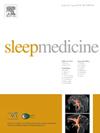失眠症与 24 小时大脑皮层过度亢奋有关。
IF 3.8
2区 医学
Q1 CLINICAL NEUROLOGY
引用次数: 0
摘要
研究目的大脑皮层过度兴奋被认为是失眠症的主要潜在机制。然而,大多数证据来自夜间睡眠,失眠症患者是否在整个24小时睡眠/觉醒周期中都存在大脑皮层过度兴奋的问题尚未解决:我们纳入了 49 名失眠症患者和 49 名年龄与性别匹配的正常睡眠者。所有参与者都接受了夜间多导睡眠图检查,然后在白天接受了多重睡眠潜伏期测试。计算了清醒和非快速眼动(NREM)睡眠时,夜间和白天脑电图中心衍射处的delta、theta、alpha、sigma和beta相对功率。失眠症的定义基于《国际睡眠障碍分类》第三版标准。客观睡眠时间短的失眠症被定义为失眠症患者的睡眠结果:与正常睡眠者相比,失眠症患者在夜间(P = 0.040)和白天(P = 0.021)NREM睡眠时β相对脑电图功率明显较高,而在夜间清醒时θ相对脑电图功率略低(P = 0.060)。此外,在正常睡眠者、睡眠时间≥7 小时的失眠症患者和睡眠时间为结论的失眠症患者中都观察到了线性趋势关联:夜间和白天睡眠时脑电图高频功率的增加表明,失眠是一种 24 小时大脑皮层过度唤醒的疾病。降低夜间和白天的大脑皮层唤醒水平应成为我们治疗失眠症的目标。本文章由计算机程序翻译,如有差异,请以英文原文为准。
Insomnia disorder is associated with 24-hour cortical hyperarousal
Objective
Cortical hyperarousal has been proposed as a primary underlying mechanism for insomnia disorder. However, most evidence comes from nighttime sleep and whether patients with insomnia disorder have cortical hyperarousal through the 24-h sleep/wake cycle is not resolved.
Methods
We included 49 patients with insomnia disorder and 49 age-and sex-matched normal sleepers. All participants underwent an over-night polysomnography followed by a Multiple Sleep Latency Test during daytime. Nighttime and daytime delta, theta, alpha, sigma and beta relative power at central electroencephalogram derivations during wakefulness and non-rapid eye movement (NREM) sleep were calculated. Insomnia disorder was defined based on the International Classification of Sleep Disorders Third Edition criteria. Insomnia with objective short sleep duration was defined as patients with insomnia who slept <7 h based on nighttime polysomnography recording.
Results
Compared to normal sleepers, patients with insomnia disorder had significantly higher nighttime (P = 0.040) and daytime (P = 0.021) relative electroencephalogram power in beta during NREM sleep and marginally significantly lower relative electroencephalogram power in theta (P = 0.060) during nighttime wakefulness. Furthermore, linear trend association was observed across normal sleepers, and patients with insomnia who slept ≥7 h and insomnia who slept <7 h in relative electroencephalogram power in beta during nighttime and daytime NREM sleep, and relative electroencephalogram power in theta during nighttime wakefulness (all P for trend <0.05).
Conclusion
Increased high-frequency electroencephalogram power during nighttime and daytime sleep suggests that insomnia is a disorder of 24-h cortical hyperarousal. Decreasing both nighttime and daytime cortical arousal levels should be our therapeutic target for insomnia.
求助全文
通过发布文献求助,成功后即可免费获取论文全文。
去求助
来源期刊

Sleep medicine
医学-临床神经学
CiteScore
8.40
自引率
6.20%
发文量
1060
审稿时长
49 days
期刊介绍:
Sleep Medicine aims to be a journal no one involved in clinical sleep medicine can do without.
A journal primarily focussing on the human aspects of sleep, integrating the various disciplines that are involved in sleep medicine: neurology, clinical neurophysiology, internal medicine (particularly pulmonology and cardiology), psychology, psychiatry, sleep technology, pediatrics, neurosurgery, otorhinolaryngology, and dentistry.
The journal publishes the following types of articles: Reviews (also intended as a way to bridge the gap between basic sleep research and clinical relevance); Original Research Articles; Full-length articles; Brief communications; Controversies; Case reports; Letters to the Editor; Journal search and commentaries; Book reviews; Meeting announcements; Listing of relevant organisations plus web sites.
 求助内容:
求助内容: 应助结果提醒方式:
应助结果提醒方式:


